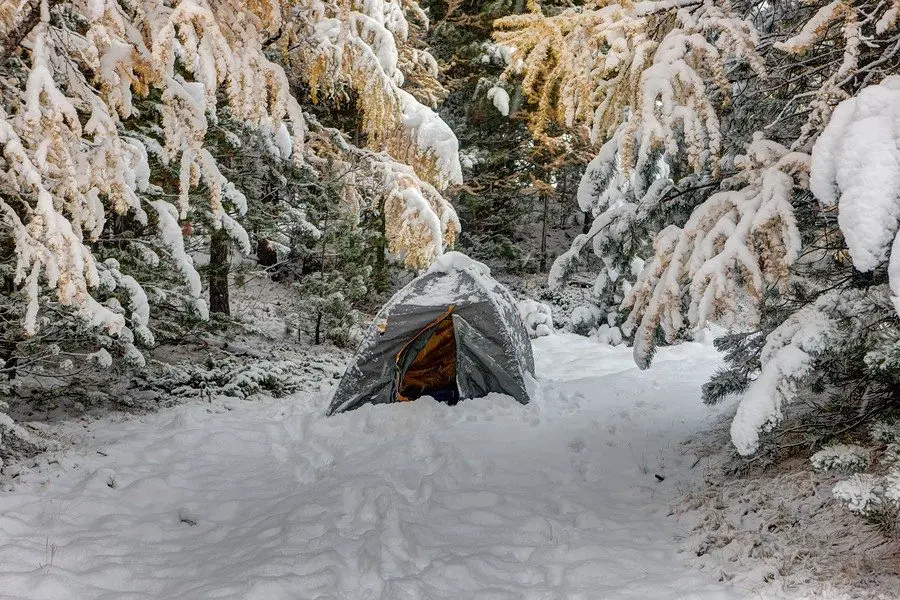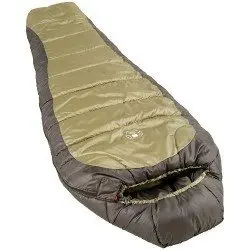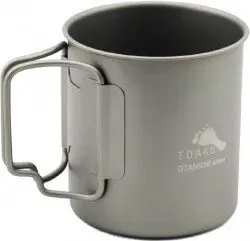Cold Weather Camping Tips

While some winter campers drive to cabins equipped with all the comforts of home, others haul their gear on snowmobiles or backpack into the wilderness. The snow offers a peaceful beauty of a pristine winter wonderland free from crowds. You can experience the serene countryside as the snow glistens in the moonlight. Whether you plan to take a day trip or an extended excursion into the backcountry during your expedition, you must be prepared for the cold weather. The trip will be rewarding and safe with some advance planning and the right equipment. These are a few important items to think about when preparing your cold weather camping checklist.
Pre-trip Planning
Because winter camping trips feature different challenges than those occurring during warm weather, you need to be prepared for shorter days and extreme weather conditions. Before you leave, you need to have a plan and let someone know where you will be and when you will return. Study the maps of the area, plan your routes and check the weather forecast. Ensure that you know how and where to contact emergency services in the event that you need assistance. Verify that you have packed all required winter clothing and camping equipment.
Dress Properly
A basic rule of winter camping is to stay warm and dry in order to prevent serious cold weather health issues, such as frostbite and hypothermia. Depending upon the conditions, you must also cover exposed skin as well as your head and neck to prevent heat loss. The best technique is to dress in layers. This will enable you to add or remove clothing as necessary to maintain a comfortable body temperature even when you stop moving. When you take a break, add a layer of clothing. It is better to conserve warmth than to have your body use its vital reserves to warm up again. Avoid cotton clothing. The fabric is difficult to dry when it gets wet. Dark colors are preferable because they absorb the sun’s warmth.
- The base layer should consist of polyester or merino wool thermal underwear. These fabrics wick perspiration away from your skin so that it can evaporate. They also dry quickly.
- The insulating middle layer is primarily designed to retain body heat. Consider micro-fleece pants as well as lightweight fleece or down-filled jackets.
- The outer layer should be waterproof or water-resistant as well as fire-resistant. This will help prevent stray embers from the campfire landing on your clothes and igniting them. Wool is an excellent natural material. Other weatherproof materials include Gore-Tex, eVent or less expensive polyurethane-coated fabrics. Select clothes with core vents and underarm vents for better release of excess heat and moisture.
- Boots should be waterproof or water-repellent and suitable for the expected environmental conditions. Wear wool or wicking polyester footwear. If your boots have removal liners, keep them warm and dry by placing them in the foot of your sleeping bag. Before putting them in the bottom of a sleeping bag, wrap single layer boots in a waterproof material. You can get high quality hiking boots for well under $200.
- Hats, scarves and gloves will prevent heat loss and protect your extremities. Pack polyester glove liners and gloves or mittens as well as small chemical heat pads if case you need extra warmth. You need a backup hat and an extra pair of gloves in the event that the original gear becomes wet. Protect your face with sunglasses and sunscreen.
Cold Weather Equipment
In addition to dressing properly, the right equipment will make the trip more enjoyable. It will protect you from the elements and provide a reasonably good night sleep.
The shelter should be an insulated four-season tent with a solid fabric enclosure that can withstand strong winds and snow. A double-walled design provides additional insulation. A small tent has less empty air space and is easier to heat. Use a ground cloth to prevent moisture from wicking up into the tent. In addition to providing warmth, a candle lantern can help reduce condensation. Hang the candle properly so that it is not a fire hazard.
 Your sleeping bag should be rated for at least 10 degrees Fahrenheit lower than what you expect to experience at night - check out the Coleman North Rim 0 Degree Sleeping Bag if you're going into very cold temperatures. If you get too warm, you can always vent the bag. Add a bag liner to improve the sleeping bag’s temperature rating if your current bag is not sufficient. Pack a closed cell-foam sleeping pad that is at least 1-inch thick. Pads are rated with an R-value from 1 to 8. The level of insulation increases with the number. Change out of damp clothing that you wore during the day so that you are warm inside the sleeping bag. In the morning, turn the bag inside out and drape it across the tent to allow it to air dry.
Your sleeping bag should be rated for at least 10 degrees Fahrenheit lower than what you expect to experience at night - check out the Coleman North Rim 0 Degree Sleeping Bag if you're going into very cold temperatures. If you get too warm, you can always vent the bag. Add a bag liner to improve the sleeping bag’s temperature rating if your current bag is not sufficient. Pack a closed cell-foam sleeping pad that is at least 1-inch thick. Pads are rated with an R-value from 1 to 8. The level of insulation increases with the number. Change out of damp clothing that you wore during the day so that you are warm inside the sleeping bag. In the morning, turn the bag inside out and drape it across the tent to allow it to air dry.
Use new lithium batteries in your headlamps, flashlights, communication equipment and emergency devices. Lithium batteries perform better in colder temperatures than NiMh and alkaline batteries. They last longer and have a flat decay curve.
Choose the Right Campsite
Make sure that there is enough daylight left when you stop for the day. The location should be sheltered from the wind, have a source of water nearby and be free from possible avalanches and falling trees. Landmarks will help you find the campsite in the dark. Determine where the sun will rise. A sunny spot will help you to warm up quicker and dry your gear faster. Start a fire before laying out your gear. You can use waterproof matches or a lighter to ignite dryer lint. Another option is to use a magnesium fire starter and natural kindling. If there is snow on the ground, pack it down before setting up the tent. This will reveal and help you avoid hidden objects like sharp rocks and sticks, which can damage the floor of the tent.
Food and Cooking Tips
 Hiking, skiing or snowshoeing burns a tremendous amount of calories. Eat a variety of proteins, fats and carbohydrates before, during and after your activities to help your body recover. Proteins build muscle and body tissue. While carbohydrates provide short-term energy, fats offer long-term energy. During activities, consume prepared energy bars and drinks. When you make camp, consider one-pot meals that are quick to prepare. Freeze-dried entrees only need hot water. Remember to bag your trash and carry it out. There is no guarantee that the snow is sterile, so boil it before drinking or cooking (I recomend the Tokas mug shown at the left). Leave water filters at home. Chemical filters take a long time to function in the cold and mechanical filters may crack and fail. A sheltered spot provides the best conditions for cooking. If possible, dig a trench 3 feet deep to protect the cooking area from the wind. Avoid alcohol and caffeine because they promote heat loss.
Hiking, skiing or snowshoeing burns a tremendous amount of calories. Eat a variety of proteins, fats and carbohydrates before, during and after your activities to help your body recover. Proteins build muscle and body tissue. While carbohydrates provide short-term energy, fats offer long-term energy. During activities, consume prepared energy bars and drinks. When you make camp, consider one-pot meals that are quick to prepare. Freeze-dried entrees only need hot water. Remember to bag your trash and carry it out. There is no guarantee that the snow is sterile, so boil it before drinking or cooking (I recomend the Tokas mug shown at the left). Leave water filters at home. Chemical filters take a long time to function in the cold and mechanical filters may crack and fail. A sheltered spot provides the best conditions for cooking. If possible, dig a trench 3 feet deep to protect the cooking area from the wind. Avoid alcohol and caffeine because they promote heat loss.
Hygiene Tips
Because of the need to stay hydrated, you may have to urinate frequently. Rather than completely disrobe or undo a sleeping bag, consider using a well-marked bottle for urination. Ensure that it has a different color, label and material than your water bottles. A distinctive texture will make it readily identifiable at the night. If the ground is too hard for catholes, you can also burn your waste and toilet paper. Another option is to haul it out using sanitary kits that include a bag neutralizer.
While most people prefer warmer weather, cold weather camping can also be an enjoyable activity as there are fewer insects. It may also offer more solitude. With some advance planning, you will have the right gear to stay safe, warm and dry.


